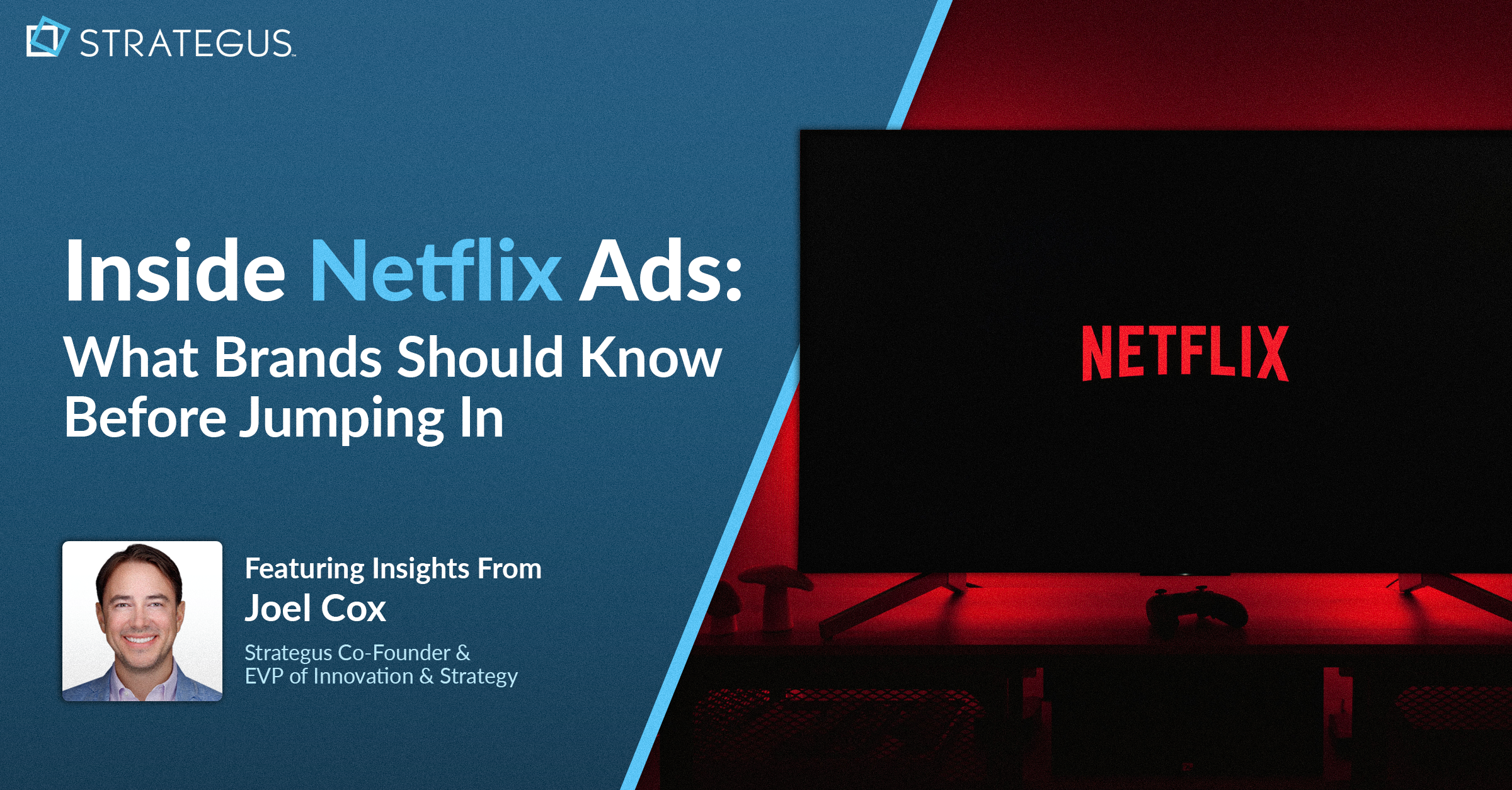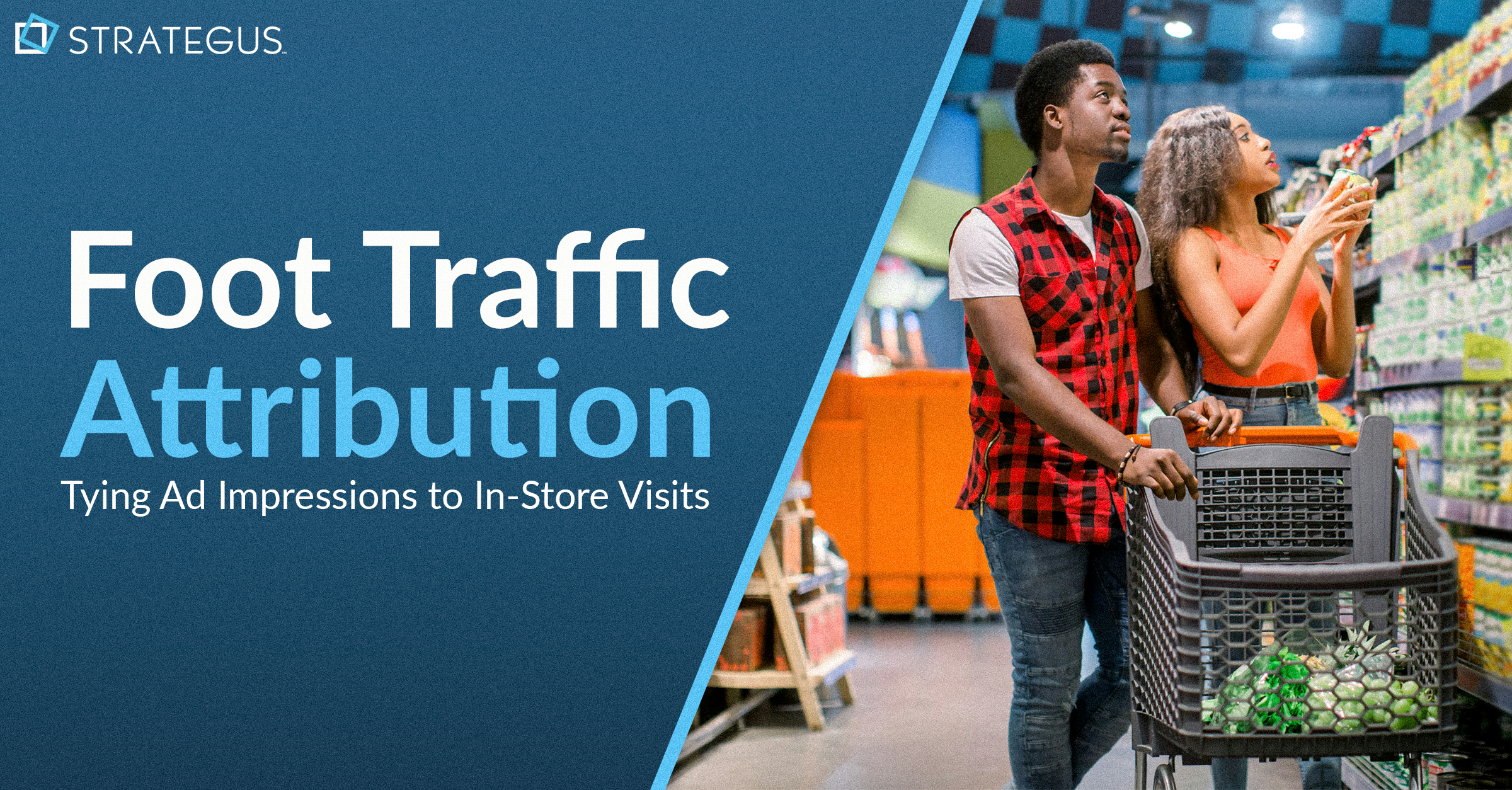- Home
- Strategus Blog
- Advertising on Netflix: What Brands Should Know Before Jumping In
Advertising on Netflix: What Brands Should Know Before Jumping In
 Joel Cox
Joel Cox
5 minutes read

A few years ago, Netflix was the ad-free paradise we all turned to for uninterrupted binge-watching. But today, keeping up with every streaming service is practically a full-time job—and an expensive one.
With our favorite shows scattered across Max, Prime, Apple TV+, Disney+, and more, paying top dollar for every subscription just isn’t sustainable. So, when Netflix introduced an ad-supported tier at $6.99/month, it gave viewers a way to stay loyal without breaking the bank. Users can cut their subscription fees in half by opting for a few ads instead of shelling out $15.49 for the ad-free version.

But let’s be clear: this move isn’t just about giving users more options. For Netflix, ad-supported memberships—up 35% in the past year—mean a fresh revenue stream and a powerful way to tap into a new market. As long as Netflix keeps ads relevant and unobtrusive, it’s unlocked a major growth engine.
So, what’s the ad experience on Netflix like so far? And as Netflix dives deeper into ads, will more brands hop on board? Let’s explore what’s next in Netflix’s advertising evolution.
The Netflix Ad Experience: Not What You’d Expect (Yet)
Netflix has always been a pioneer. This is the company that turned movie rentals on their head, transformed TV, and launched the streaming revolution. Innovation is embedded in Netflix’s DNA. So, you’d think they’d have an advertising experience to match, right? Well, not exactly—at least, not yet.
When Netflix introduced ads in November 2022, they did so by partnering with Microsoft’s DSP (Demand Side Platform) in an exclusive deal that guaranteed revenue. But it also limited advertiser access by restricting targeting and personalization options—an unexpected choice for a company known for breaking the mold.
Then came a major shake-up.
In early 2024, Amazon moved all Prime Video subscribers to ad-supported plans by default, instantly creating the largest ad-supported streaming audience. This bold move pushed Netflix to rethink its strategy. In response, Netflix ended its exclusive deal with Microsoft, brought in new ad-tech partners like Google, The Trade Desk, and Magnite, and expanded its ad inventory. This pivot opened Netflix up to more advertisers, giving the company a chance to catch up and compete.

If we’re being real, Netflix still has ground to cover. All signs point to Netflix building its own tech stack to boost ad performance and gain more control, but these things take time. In the meantime, Netflix is using these new DSP partnerships to expand advertiser access and better understand the ropes of ad-supported streaming. It’s a fascinating transition, but it’s also clear that Netflix is still in the early stages of creating an ad experience that can live up to its reputation as a trailblazer.
Brand Awareness First: Netflix’s Old-School Ad Targeting

At first glance, Netflix’s ad offering feels, well… old-school. Instead of the advanced, data-rich targeting digital advertisers expect, Netflix organizes its ad inventory by broad genre categories like sports, horror, or drama. Think linear TV—brands reach audiences based on content type but miss out on precise, data-driven audience insights.
The irony? Netflix, the disruptor of cable, is now leaning on a model that feels a lot like traditional TV. Genre-based targeting may help brands reach large, engaged audiences, but it lacks the detail and specificity advertisers have come to expect.
And measurement? That’s still a work in progress. Advertisers hoping to track every click, conversion, or ROI won’t find much luck here. Unlike platforms with attribution that links ad exposure to sales, Netflix’s ads are better suited for brand awareness than direct conversions. Right now, it’s less about driving immediate purchases and more about aligning a brand with Netflix’s loyal viewer base.
The Ad Trade-Off: Why Netflix Ads Work for Some Brands, But Not All
For now, Netflix’s ad model is best suited for brands focused on building awareness and associating with premium content. Here’s what it boils down to:
- Broad Reach, But Minimal Precision: Netflix’s genre-based targeting casts a wide net but misses the granular data advertisers crave.
- Strong Brand Alignment: Brands looking for cultural relevance can benefit from Netflix’s cachet, especially if they value being associated with iconic shows.
- Lacks Direct Performance Metrics: If conversions and ROI tracking are critical to your campaign, Netflix’s ad experience might feel too limited.
- Still a Growing Platform: Netflix’s ad capabilities are evolving, so early adopters have a chance to secure a foothold as the platform matures.
Netflix is still a high-stakes bet for advertisers, especially those more focused on cultural impact than immediate sales.
So, What’s Next for Netflix?
As Netflix ramps up its ad game, it’s stepping into a fiercely competitive field. While Amazon’s ecosystem benefits from massive subscriber data, Netflix has something unique—cultural influence and a premium content library. Netflix’s audience spends an average of over two hours per day streaming, making it one of the most engaged audiences in the world.

The real challenge? Building an ad platform that’s as innovative as Netflix’s content. Will they develop a DSP of their own or rely on DSP partners to bring the best ad tech? Either way, Netflix’s approach to ads has the potential to shape the future of ad-supported streaming, blending high-quality content with evolving ad capabilities.
Why Advertisers Should Pay Attention Now
Yes, Netflix’s ad model is still evolving. It doesn’t yet deliver the precision or advanced measurement that platforms like Amazon offer. But for brands today, Netflix provides something else: a direct link to some of the most compelling original content in streaming history. Advertisers opting in now get exposure alongside shows like Stranger Things, Bridgerton, and Emily in Paris—cultural landmarks that keep viewers coming back.
We’ve had a front-row seat to Netflix’s ad evolution, and while it’s still early days, we fully expect their tech stack to mature and deliver a more sophisticated ad experience over time. But advertisers need the right expectations: Netflix’s current ad tier is about visibility and brand alignment rather than direct conversions. For those seeking broad reach alongside popular content, Netflix is a powerful option, with more to come as the platform’s ad capabilities grow.
If you'd like to learn more about making Netflix ads work for your brand, Strategus is here to help. Contact us today to get started.

Joel Cox keeps Strategus ahead of the curve by driving ongoing product enhancements and forging new integrations across the industry. He’s been setting the pace of innovation since co-founding Strategus in 2013. His past work has been featured in Ad Exchanger, Ad Week, The Current by The TradeDesk, and more.
Strategus is a managed services connected TV(CTV) advertising agency with over 60,000+ campaigns delivered. Find out how our experts can extend your team and drive the result that matter most.
Talk to an Expert
Table of Contents
Seeking a Custom CTV Strategy That Delivers?
What to read next

Third-Party Data Targeting for CTV: Benefits & Tactics
Third-party data. It’s a term that’s thrown around, and yet few take the time to detail its pros and cons — much less strategies for using...
7 minutes read

First-Party Data Targeting: Benefits and Tactics for CTV Advertising
First-party data is the information that companies collect directly from their customers rather than through intermediaries. Advertisers use this...
10 minutes read

Foot-Traffic Attribution: Tying Ad Impressions to In-Store Visits
The marketing funnel has changed. Today’s shoppers often begin researching products from the comfort of their homes and don’t set foot into a store...
8 minutes read

CTV Attribution: What It Is and How It Works
Connected TV (CTV) viewing is on the rise — and that’s good news for marketers. Not only can CTV ads be precisely targeted to individual households,...
9 minutes read















